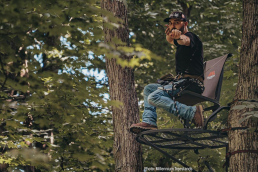Treestand Placement for Rutting and Post-Rut Whitetails
SHARE THIS POST
As white-tailed deer move into the late- and post-rut periods, they change their feeding habits and behavior. Successful deer hunters should change their tactics as well. This is especially true of treestand placement.
The latter part of deer season for bowhunters, and the start of firearms seasons, is a time to move back into the deep cover of woods, swamps, farmland sloughs, river bottoms and thick stands of cattails.
Big bucks will stay there and not go out to feed with does and yearlings. The rigors of the rut and dodging hunters wears them out. They seek isolated locations to rest. They find the nastiest, thickest cover around and stay there. Hunters must go in there, too, if they want a big buck.
During the rut, placing a stand over a breeding scrape is a good bet. All scrapes are not breeding scrapes. They differ in both size and location.
Breeding scrapes are usually 2 to 4 feet in diameter and normally found in heavy cover with an overhanging bush or tree limb. Deer muddy the scrape with deer urine and leave tracks in it.
Territorial scrapes are smaller and made in more open areas. They are usually located at the corners of wooded areas or along grain or alfalfa field edges.
To hunt a breeding scrape, position your stand downwind of the scrape about 20 yards, high up a tree. As the buck approaches a scrape, he usually does so from downwind. Do not go anywhere near the scrape to avoid contaminating it with human scent.
After selecting the area for the stand, pick the exact location. Try to predict what the deer sees and where he will travel as he passes the stand location.
Place the stand in natural surroundings. Use available materials to camouflage both you and the stand. If there is a chance that a rising or setting sun might outline you, forget that location. You could sit there all season and not see a deer.
Are you enjoying this post?
You can be among the first to get the latest info on where to go, what to use and how to use it!
Bowhunters in particular need a clear shot, as a single twig can deflect an arrow and ruin the chance at the buck of a lifetime. Tailor the spot to meet the need for clear shooting alleys by tying back branches and brush the areas you think a shot will present itself. Remember to later untie the branches and leave the woods the way you found them. This is better than cutting branches for cover or for stands.
Choose a stand location that you can get into and out of with a minimum of disruption to the surroundings. Plan your path to the stand so that it will not encounter a trail along which a deer might travel. It is important that deer not know you are in the area. If possible, enter the area with the wind in your face.
A tree in a clump of trees is better than one in a more open setting, no matter how good the shooting lanes. A pine tree with some limbs cut away works well if you are conscious of what deer will see from ground level. Even better is just tying back the limbs so that when you finish with the stand, simply cut the string and the branches will go back to their original place without damage to the tree.
Remember, you will be in the stand for a long time. Think about your comfort and ability to remain still. People have different levels of tolerance for discomfort. Judge your stand according to yours.
Once the stand is in place, you might have to move it. If you do, then do not use it for a few days so that deer become accustomed to its presence. You might even place a gunnysack full of leaves in it so that they become used to seeing a shape in it. Later, remove the sack and replace it with you.
Think like a deer when considering treestand placement. It is hard work, but pays dividends during hunting season.
If you enjoy hunting, you’ll find suggestions for locations and techniques in every issue of MidWest Outdoors, available by subscribing on our website.
MWO
SHARE THIS POST
You may also like...
Nothing found.
Did you enjoy this post?
You can be among the first to get the latest info on where to go, what to use and how to use it!
Don Gasaway
Don Gasaway is a veteran freelance outdoor writer from Marion, Ill. He may also be found at: https://www.facebook.com/DonGasawayWriter and facebook.com/Wandering Angler. Comments are welcome
